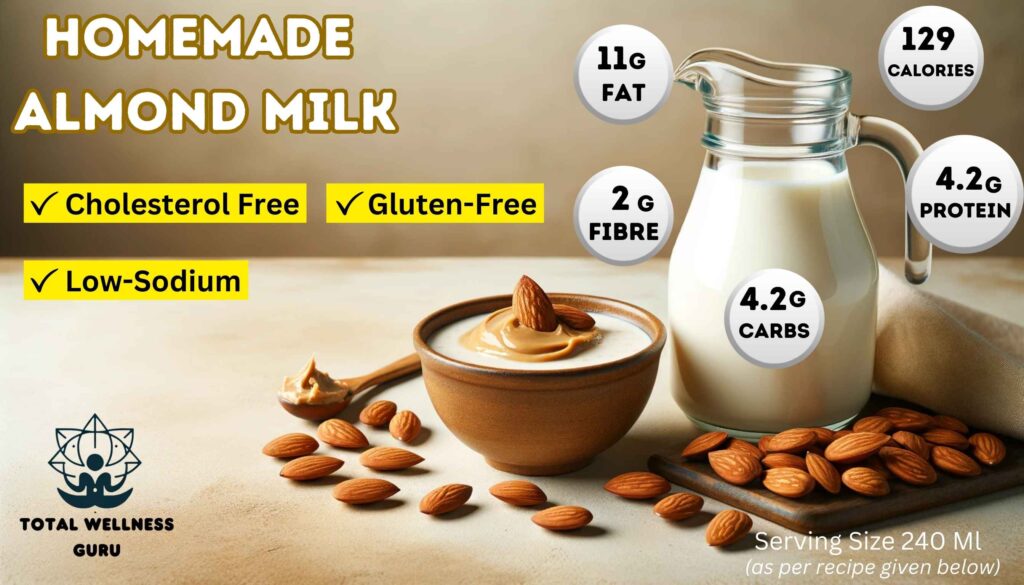
Contents of this Blog
Toggle5 Surprising Nutritional Facts: Almond Milk Calories using Homemade Almond Butter Recipe
Curious about the nutritional profile and count of your almond milk calories ? What if you could craft this low-calorie delight from scratch using homemade almond butter recipe?
Welcome to a delightful exploration of Almond Milk Calories and the art of creating almond butter at home. This journey is not just about sipping a plant-based milk alternative; it’s an adventure into crafting nutritious, delicious almond milk right in your kitchen. As we unravel the secrets behind almond milk’s low-calorie benefits and guide you through an easy, satisfying homemade almond butter recipe, prepare to be amazed. Whether you’re health-conscious, diabetic conscious, managing waistline, managing dietary needs, or simply seeking culinary creativity, this guide is your gateway to the wholesome world of almonds.
Almond Milk Calories Made from Homemade Almond Butter Nutritional Facts
The following nutrition information is based on 2 tablespoons of Plain Almond Butter (no salt or sugar added) used with 240 ml of water. Almond Butter values as provided by the USDA.
Serving Size: 1 cup (240 ml)
Nutritional Values (Approximate):
- Calories: 129 kcal
- Fat: 11 g
- Cholesterol: 0 mg
- Total Carbohydrates: 4.2 g
Dietary Fiber: 2 g
Sugar: 1 g - Protein: 4.2 g
- Sodium: 1 mg
- Calcium: 52.8 mg
- Iron: 0.8 mg
- Potassium: 149 mg
- Vitamin E: 3.3 mg
- Magnesium: 54 mg

Almond Milk Calories – A Nutritional Powerhouse
What Makes Almond Milk a Must-Have in Your Diet?
I remember the first time I swapped my usual dairy milk for almond milk in my morning coffee. The change was not just in taste but in how my body felt throughout the day.
Have you ever considered what’s behind the surge of almond milk in fridges across America? Is this nutty sensation more than just a low-calorie alternative to dairy milk ?
Almond milk, a creamy and delightful plant-based drink, has become a staple in the diet of the health-conscious. It’s not just a trend; it’s a nutritional powerhouse. One of its most celebrated aspect are not just the almond milk calories count but the goodness packed in them.
Nutritionally, almond milk is a gold mine. It’s rich in Vitamin E, a powerful antioxidant that protects your cells from damage. Also, it’s a good source of minerals like magnesium and calcium, essential for bone health and overall well-being.
Heart health is another area where almond milk shines. It’s naturally low in saturated fats and free from cholesterol, which can be beneficial for maintaining a healthy heart and keeping cholesterol levels in check, supporting the cardiovascular health.
And for individuals who are lactose intolerant or have a sensitivity to dairy milk, almond milk offers a soothing alternative to enjoy your cereal or smoothie without the digestive discomfort often associated with dairy products.
What is worth mentioning is its environmental impact too . Almonds require less water and generate a lower carbon footprint compared to dairy farming, making almond milk a more sustainable choice.
But it’s not just about what’s inside. Making almond milk at home allows you to control the ingredients, ensuring there are no unnecessary additives or excess sugars. Plus, the process of blending and straining almonds is surprisingly simple and quite satisfying!
In summary, the low almond milk calories tag is just the tip of the iceberg. It’s a drink that offers numerous health benefits, caters to various dietary needs, and even plays a part in environmental sustainability. It’s no wonder almond milk has become a favorite in households nationwide, symbolizing a shift towards more conscious and health-oriented eating habits.

Have you ever pondered the simplicity and satisfaction of making homemade almond butter?
The Homemade Almond Butter Recipe
The first time I made almond butter, I was amazed by the transformation of simple almonds into this creamy, rich spread. It was a Sunday afternoon experiment that turned into a weekly kitchen ritual.
The process starts with selecting high-quality almonds. These nuts are not only the base for our almond milk but also the star ingredient in our almond butter. Once you have your almonds, the rest is surprisingly straightforward.
Ingredients:
2 cups of high-quality whole almonds
Optional: Pinch of salt, honey, or cocoa powder for flavor
Instructions:
Preheat Oven: Start by preheating your oven to 350°F (175°C). This temperature is ideal for roasting almonds.
Roast Almonds: Spread the almonds in a single layer on a baking sheet. Place them in the oven and roast for about 10-12 minutes. Keep an eye on them to ensure they don’t burn. Roasting is essential as it brings out the almonds’ rich, nutty flavor.
Cool Down: Once the almonds are roasted to a golden brown, remove them from the oven. Let them cool down to room temperature. This step is crucial as blending hot almonds can affect the texture of the butter.
Blend Almonds: Transfer the cooled almonds to a food processor. Blend on high speed. Initially, the almonds will turn into a coarse meal. Continue blending – this could take several minutes. Be patient as the almonds slowly release their oils and transform into a smooth, creamy butter.
Customize Flavor (Optional): If you prefer flavored almond butter, now is the time to add your extras. For a simple touch, add a pinch of salt. For sweetness, a drizzle of honey is perfect. If you’re a chocolate lover, a sprinkle of cocoa powder can add a chocolatey twist. Blend again to incorporate any added flavors.
Texture Check: The final texture should be smooth and spreadable. If it’s too thick, you can add a small amount of almond oil or any neutral-tasting oil to adjust the consistency.
Store: Transfer your homemade almond butter to an airtight container. It can be stored in the refrigerator for up to two weeks.
Homemade Almond Butter Recipe For The Quickest and Lowest Almond Milk Calories:
The beauty of homemade almond milk lies in its simplicity and purity, especially when it’s made from homemade almond butter. This method is not only quick but also allows you to bypass the long soaking and straining process typically associated with making almond milk from scratch. Here’s how you can transform your homemade almond butter recipe into a creamy almond milk drink.
Ingredients:
2 tablespoon of homemade almond butter
1.5 cups of water (adjustable for preferred consistency)
Optional for flavor: Natural sweetener (like honey or dates), vanilla extract, or cinnamon.
I love adding a touch of honey and a dash of cinnamon to my almond milk – it reminds me of cozy, lazy mornings.
Instructions:
Prepare Your Blender: Ensure your blender is clean and ready to use. This recipe works best with a powerful blender for a smooth consistency.
Combine Ingredients: In the blender, add 2 tablespoon of your fresh homemade almond butter. This butter, free from additives and preservatives, offers pure almond goodness. Pour 1.5 cups of water into the blender. The amount of water can be varied based on your preference for thickness; less water for thicker milk, more for a thinner consistency.
Blend the Mixture: Secure the lid of your blender and blend the mixture on high. Continue blending for about one to two minutes or until the mixture becomes smooth and creamy. The exact time may vary slightly depending on your blender’s power.
Customize Your Almond Milk (Optional): If you prefer a sweetened version, add a natural sweetener like honey or dates. For an extra flavor, consider adding a drop of vanilla extract or a sprinkle of cinnamon. Blend again briefly to incorporate these flavors.
Check Consistency: After blending, check the consistency of your almond milk. It should be smooth and creamy. If it’s too thick, you can add a little more water and blend again.
Serve and Enjoy: Your homemade almond milk is now ready to be enjoyed. It’s perfect for adding to coffee, cereal, smoothies, or just drinking on its own.
Storage: If there are leftovers, store your homemade almond milk in a sealed container in the refrigerator. It’s best consumed within a few days.

This almond milk made from homemade almond butter recipe offers a quick, nutritious, and delicious alternative to store-bought versions. It’s a testament to the simplicity and joys of DIY, aligning perfectly with a lifestyle focused on mindful eating and sustainable living. Enjoy the freshness and satisfaction of creating your own almond milk at home!
Curious about the buzz linking almond milk testosterone levels and wondering if it is true?
A friend once asked me if drinking almond milk would affect his gym routine and muscle building, sparking my curiosity about the relationship between almond milk and testosterone.
Can Almond Milk Really Affect Your Testosterone Levels?
It’s time to explore this intriguing aspect and separate fact from fiction.
The relationship between diet and hormone levels, particularly testosterone, has always been a topic of interest. Almond milk, a staple in many health-conscious diets, comes into focus here. But what does the science say about almond milk testosterone effects?
Firstly, it’s essential to understand that almonds themselves contain nutrients that are beneficial for overall health, including hormonal balance. They are rich in healthy fats, which are crucial for hormone production, including testosterone. However, the direct impact of almond milk on testosterone levels is a subject that requires more in-depth research.
There are some theories and anecdotal evidence suggesting that the plant compounds in almonds might influence hormone levels, but these claims need more scientific backing. It’s also important to note that diet is just one factor that affects testosterone levels. Other factors like lifestyle, overall health, and genetics play significant roles.
For men concerned about testosterone levels, incorporating almond milk as part of a balanced diet can be a wise choice. Not only is it nutritious, but it also provides a healthy alternative to dairy milk, which some studies suggest could impact hormone levels due to its content of animal hormones and other compounds.
In the case of women, the impact of almond milk on hormones, including testosterone, is even less clear. Women do produce testosterone, although in smaller amounts compared to men, and it plays a role in health and well-being. As with men, a balanced diet that includes foods like almond milk can contribute to overall hormonal health.

But Is Almond Milk Good For Diabetic People ?
For individuals with diabetes, managing blood sugar levels is a daily consideration. This is where almond milk, particularly unsweetened varieties, comes into play. Its low glycemic index means it won’t spike blood sugar levels, making it a safe and satisfying choice for diabetics. Its low carbohydrate content means that it has a minimal impact on blood sugar, making it an excellent alternative to dairy milk and other higher-carb beverages. The key here is to choose unsweetened almond milk, as sweetened versions can contain added sugars that could affect glucose levels
.
“John, a family friend who’s been managing diabetes for years, shared how switching to almond milk significantly helped him control his sugar levels.”
Another significant aspect of almond milk for diabetics is its calorie count. The low almond milk calories content makes it a smart choice for those who are also watching their weight – a common concern for many people with diabetes. Weight management is often a crucial part of managing diabetes, and choosing low-calorie food and drink options can help in this endeavor.
Almond milk also boasts a healthy fat profile. The fats in almond milk are primarily heart-healthy monounsaturated fats, which are beneficial for cardiovascular health. This is particularly important for diabetics, as they often have an increased risk of heart disease. By incorporating almond milk into their diet, they’re not just making a choice that’s good for their blood sugar levels but also one that supports heart health.
So the next time your elderly parents asks, Is Almond milk good for Diabetic people like them? Tell them a big YES !
It’s a simple switch with potentially significant health benefits for those looking to maintain stable blood sugar levels while enjoying delicious and varied food choices.
Almond Milk for Acid Reflux: A Soothing Alternative
Can almond milk be a soothing agent for those suffering from acid reflux?
The answer is yes. Almond milk is known for its alkaline properties, making it a potentially good choice for individuals dealing with acid reflux.
“My aunt always struggled with acid reflux, especially after coffee. Once she switched to almond milk, her mornings became more comfortable.”
Unlike some dairy products that can trigger acid reflux due to their high-fat content and acidity, almond milk is low in fat and less acidic. This makes it a gentler alternative for the stomach. Including almond milk in your diet can help balance the stomach’s acidity levels, providing relief from discomfort. However, it’s essential for individuals with acid reflux to monitor their individual responses, as dietary triggers can vary.
As we reach the end of our almond journey, it’s clear that this tiny nut packs a mighty punch in terms of health benefits and culinary versatility. From the low almond milk calories that make it a smart choice for calorie-conscious individuals or the fact that almond milk good for diabetic people or using almond milk for acid reflux, to the ease and satisfaction of whipping up a homemade almond butter recipe, almonds offer something for everyone. Although its role in potentially influencing almond milk testosterone levels is a topic that warrants further exploration, but its current known benefits are impressive enough to make it a staple in any health-oriented kitchen. So, why not incorporate these almond-based delights into your daily routine and enjoy the myriad of benefits they offer?
The world of almonds is full of surprises and flavors, waiting to be explored and savored.

FAQs
Can any homemade almond butter be used for almond milk?
Yes, use any type without added sugars or preservatives.
How long does homemade almond milk stay fresh?
It lasts 3-5 days in the fridge in an airtight container.
Is homemade almond milk safe for nut allergies?
No, it’s not suitable for those with nut allergies.
Can I cook and bake with homemade almond milk?
Yes, it’s versatile for cooking and baking.
Does homemade almond milk have the same nutrients as store-bought?
Homemade is often lower in calories but may lack added vitamins and minerals.
What natural sweeteners work best for homemade almond milk?
Honey, maple syrup, or dates are great options.
Is the homemade almond butter recipe vegan?
Yes, it’s suitable for a vegan diet.
Sources:
At Total Wellness Guru, we are committed to providing only the
highest quality content, underpinned by facts from well-regarded, peer-reviewed
studies. This dedication ensures that all information presented is accurate,
dependable, and credible.
Nutritional Content of Almond Milk and Almond Butter:
U.S. Department of Agriculture (USDA) FoodData Central. Almond
Milk, Unsweetened and Almond Butter.
Health Benefits of Almond Milk:
R. R. Eitenmiller, et al., “Vitamin E Content of Fats and Oils:
Nutritional Implications,” in Food
Technology, 1997. Link to Journal
National Institutes of Health (NIH), “Magnesium Fact Sheet for Health
Professionals“. Link to
NIH
Environmental Impact of Almond Milk vs. Dairy Milk:
B. E. B. Clark, et al., “Comparative analysis of environmental impacts of
agricultural production systems, agricultural input efficiency, and food
choice,” in Environmental
Research Letters, 2017. Link to Journal
Almond Milk and Diabetes:
Mayo Clinic, “Diabetes diet: Create your healthy-eating plan”. Link to Mayo
Clinic
Almond Milk for Acid Reflux:
Cleveland Clinic, “GERD: Controlling Heartburn by Changing Your
Habits”. Link to Cleveland
Clinic

